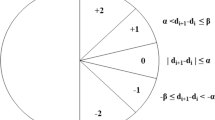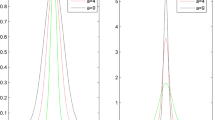Abstract
Based on reconstructing the phase space and calculating the largest Lyapunov exponent, an improved method of detecting chaotic motion is presented for rotor-bearing systems. The method is an improvement to the Wolf method and the Rosenstein algorithm. The improved method introduces the correlation integral function method to estimate the embedding dimension and the reconstruction delay simultaneously, and it makes tracks for the evolutions of every pair of the nearest neighbors to improve the utilization of the reconstructed phase space. Numerical calculation and experimental verification show that the improved method can estimate the proper reconstruction parameters and detect chaotic motion of rotor-bearing systems accurately. In addition, the analytical results show that the current approach is robust to variations of the embedding dimension and the reconstruction delay, and it is applicable to small data sets.
Similar content being viewed by others
References
Adiletta G, Guido A R, Rossi C. Chaotic motion of a rigid rotor in short journal bearing [J]. Nonlinear Dynamics, 1996, 10(3): 251–269.
Chang-Jian C W, Chen C K. Bifurcation and chaos analysis of a flexible rotor supported by turbulent long journal bearings [J]. Chaos, Solitons and Fractals, 2007, 34(4): 1160–1179.
Eckmann J P, Ruelle D. Ergodic theory of chaos and strange attractors [J]. Reviews of Modern Physics, 1985, 57(3): 617–656.
Grassberger P, Procaccia I. Characterization of strange attractors [J]. Physical Review Letters, 1983, 50(5): 346–349.
Benettin G, Galgani L, Strelcyn J M. Kolmogorov entropy and numerical experiment [J]. Physical Review A, 1976, 14(1): 2338–2345.
Kim B J, Choe G H. High precision numerical estimation of the largest Lyapunov exponent [J]. Communications in Nonlinear Science and Numerical Simulation, 2010, 15(5): 1378–1384.
Wolf A, Swift J B, Swinney H L, et al. Determining Lyapunov exponents from a time series [J]. Physica D, 1985, 16(3): 285–317.
Stefanski A, Dabrowski A, Kapitaniak T. Evaluation of the largest Lyapunov exponent in dynamical systems with time delay [J]. Chaos, Solitons and Fractals, 2005, 23(5): 1651–1659.
Shimada I, Nagashima T. A numerical approach to ergodic problem of dissipative dynamical systems [J]. Progress of Theoretical Physics, 1979, 61(6): 1605–1616.
Benettin G, Galgani L, Giorgilli A, et al. Lyapunov characteristic exponents for smooth dynamical systems and Hamiltonian systems; a method for computing all of them. Part I. Theory [J]. Meccanica, 1980, 15(1): 9–20.
Benettin G, Galgani L, Giorgilli A, et al. Lyapunov exponents for smooth dynamical systems and Hamiltonian systems; a method for computing all of them. Part II. Numerical application [J]. Meccanica, 1980, 15(1): 21–30.
Takens F. Detecting strange attractors in turbulence [J]. Lecture Notes in Mathematics, 1981, 898(1): 366–381.
Sano M, Sawada Y. Measurement of the Lyapunov spectrum from a chaotic time series [J]. Physical Review Letters, 1985, 55(10): 1082–1085.
Eckmann J P, Kamphorst S O, Ruelle D, et al. Lyapunov exponents from a time series [J]. Physical Review Letters, 1986, 34(9): 4971–4979.
Rosenstein M T, Collins J J, De Luca C J. A practical method for calculating largest Lyapunov exponents from small data sets [J]. Physica D, 1993, 65(1-2): 117–134.
Grond F, Diebner H H, Sahle S, et al. A robust, locally interpretable algorithm for Lyapunov exponents [J]. Chaos, Solitions and Fractals, 2003, 16(5): 841–852.
Kim H S, Eykholt R, Salas J D. Nonlinear dynamics, delay times, and embedding windows [J]. Physica D, 1999, 127(1-2): 48–60.
Brock W A, Hsieh D A, Lebaron B. Nonlinear dynamics, chaos, and instability: Statistical theory and economic evidence [M]. Cambridge: MIT Press, 1993: 42–54.
Sato S, Sano M, Sawada Y. Practical methods of measuring the generalized dimension and the largest Lyapunov exponent in high dimensional chaotic systems [J]. Progress of Theoretical Physics, 1987, 77(1): 1–5.
Capone G. Orbital motions of rigid symmetric rotor supported on journal bearings [J]. La Meccanica Italiana, 1986, 199: 37–46.
Author information
Authors and Affiliations
Corresponding author
Additional information
Foundation item: the National Basic Research Program (973) of China (No. 2009CB724302)
Rights and permissions
About this article
Cite this article
Shi, Ml., Wang, Dz. & Zhang, Jg. An improved method of detecting chaotic motion for rotor-bearing systems. J. Shanghai Jiaotong Univ. (Sci.) 18, 229–236 (2013). https://doi.org/10.1007/s12204-013-1387-0
Received:
Published:
Issue Date:
DOI: https://doi.org/10.1007/s12204-013-1387-0




